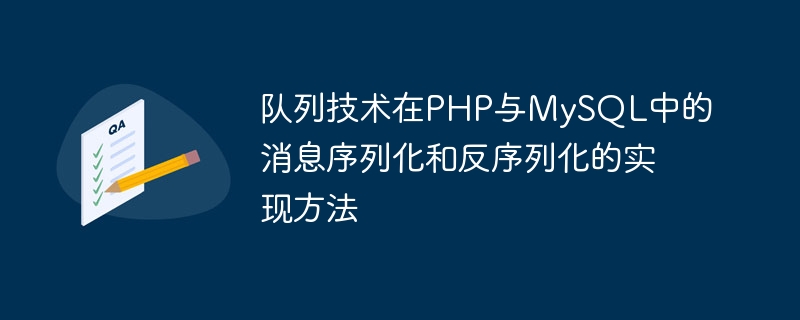

How to implement message serialization and deserialization of queue technology in PHP and MySQL
In web development, queue technology is widely used to process asynchronous tasks and message passing, which can improve the performance and scalability of the system. As a popular server-side programming language, PHP can be used in combination with the MySQL database to implement excellent web applications. This article will introduce the implementation method of message serialization and deserialization of queue technology in PHP and MySQL, and give specific code examples.
(1) Create a queue table
First, create a table named queue to store messages in the queue. The table structure is as follows:
CREATE TABLE queue (
1 2 3 |
|
);
The table contains three fields: id is the auto-incrementing primary key, data is the message content, and created_at is the message Creation time.
(2) Add a message to the queue
To add a message to the queue, you can use the following code example:
function enqueue($data) {
1 2 3 4 5 |
|
}
In the enqueue function, escape the message content $data and insert it into the queue table.
(3) Retrieve messages from the queue
To retrieve messages from the queue, you can use the following code example:
function dequeue() {
1 2 3 4 5 6 |
|
}
In the dequeue function, obtain the earliest created message through the SELECT query statement, and then delete it from the queue table.
(1) Message serialization
Serialization is the process of converting data into a format that can be stored or transmitted. Taking the serialize function as an example, the following is a simple message serialization example:
function serializeMessage($message) {
1 |
|
}
In the serializeMessage function, use serialize Function serializes $message into a string.
(2) Message deserialization
Deserialization is the process of converting stored or transmitted data into original data. Taking the unserialize function as an example, the following is a simple message deserialization example:
function unserializeMessage($serializedMessage) {
1 |
|
}
In the unserializeMessage function, use The unserialize function deserializes $serializedMessage into raw data.
// Add messages to the queue
$message = array( 'task_id' => 1, 'content' => '...');
$serializedMessage = serializeMessage($message);
enqueue($serializedMessage);
// Get the message from the queue and process it
$serializedMessage = dequeue();
$message = unserializeMessage($serializedMessage);
$taskId = $message['task_id'];
$content = $ message['content'];
processTask($taskId, $content);
In the above example code, the task message is first serialized and added to the queue; then the message is taken out of the queue , perform deserialization and process the corresponding tasks. Finally, the corresponding processing function can be implemented according to the specific task content.
Summary:
This article introduces the implementation method of message serialization and deserialization of queue technology in PHP and MySQL, and gives specific code examples. By using queue technology, orderly processing of asynchronous tasks can be achieved, improving system performance and scalability. At the same time, PHP provides a wealth of serialization and deserialization functions, which can easily handle complex message data.
The above is the detailed content of How to implement message serialization and deserialization of queue technology in PHP and MySQL. For more information, please follow other related articles on the PHP Chinese website!
 What to do if php deserialization fails
What to do if php deserialization fails
 How to execute a shell script
How to execute a shell script
 How to set startup items at startup
How to set startup items at startup
 What are the methods to change IP in dynamic vps instantly?
What are the methods to change IP in dynamic vps instantly?
 What is the appropriate virtual memory setting?
What is the appropriate virtual memory setting?
 How to use math.round function
How to use math.round function
 What are the common tomcat vulnerabilities?
What are the common tomcat vulnerabilities?
 How to lock screen on oppo11
How to lock screen on oppo11




